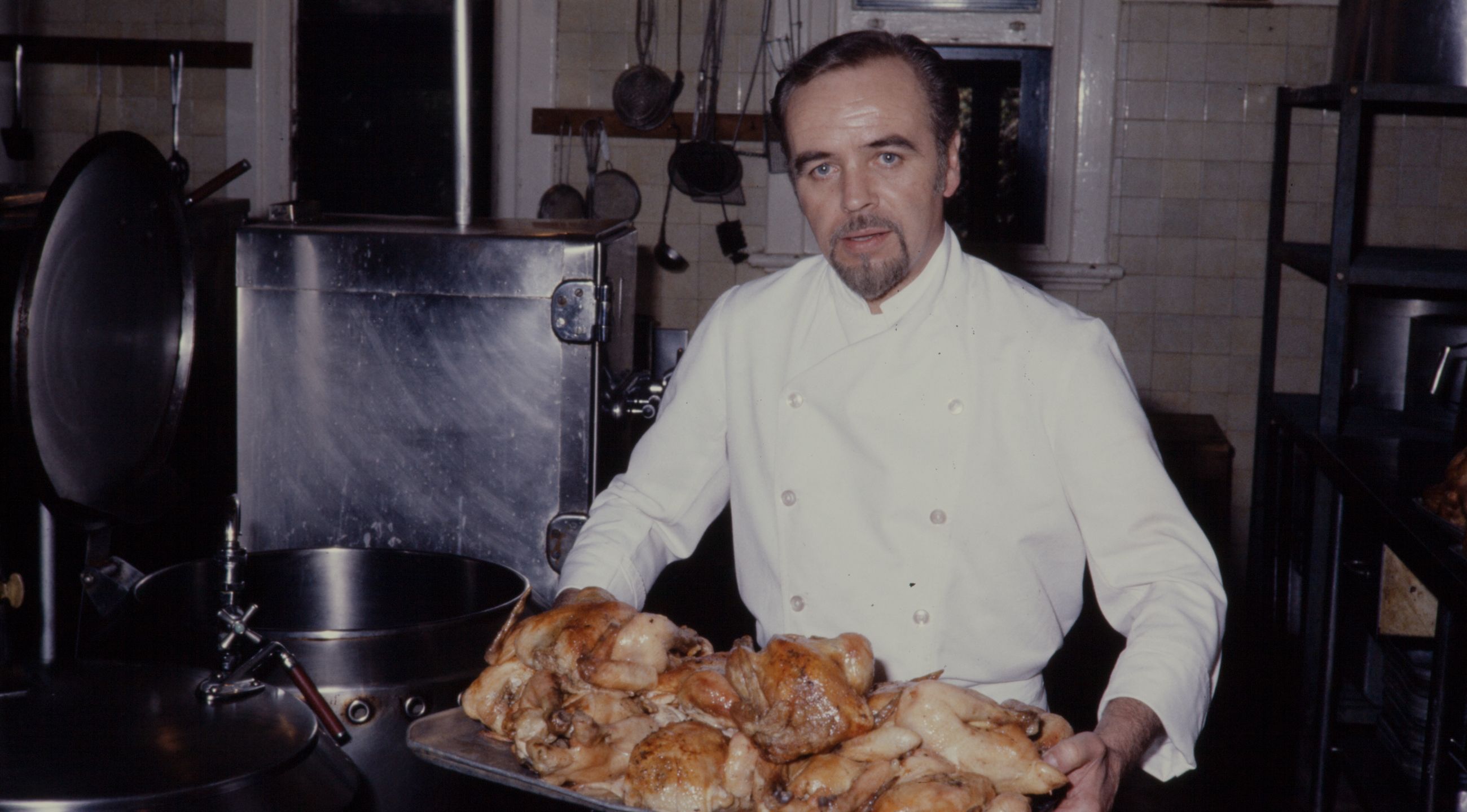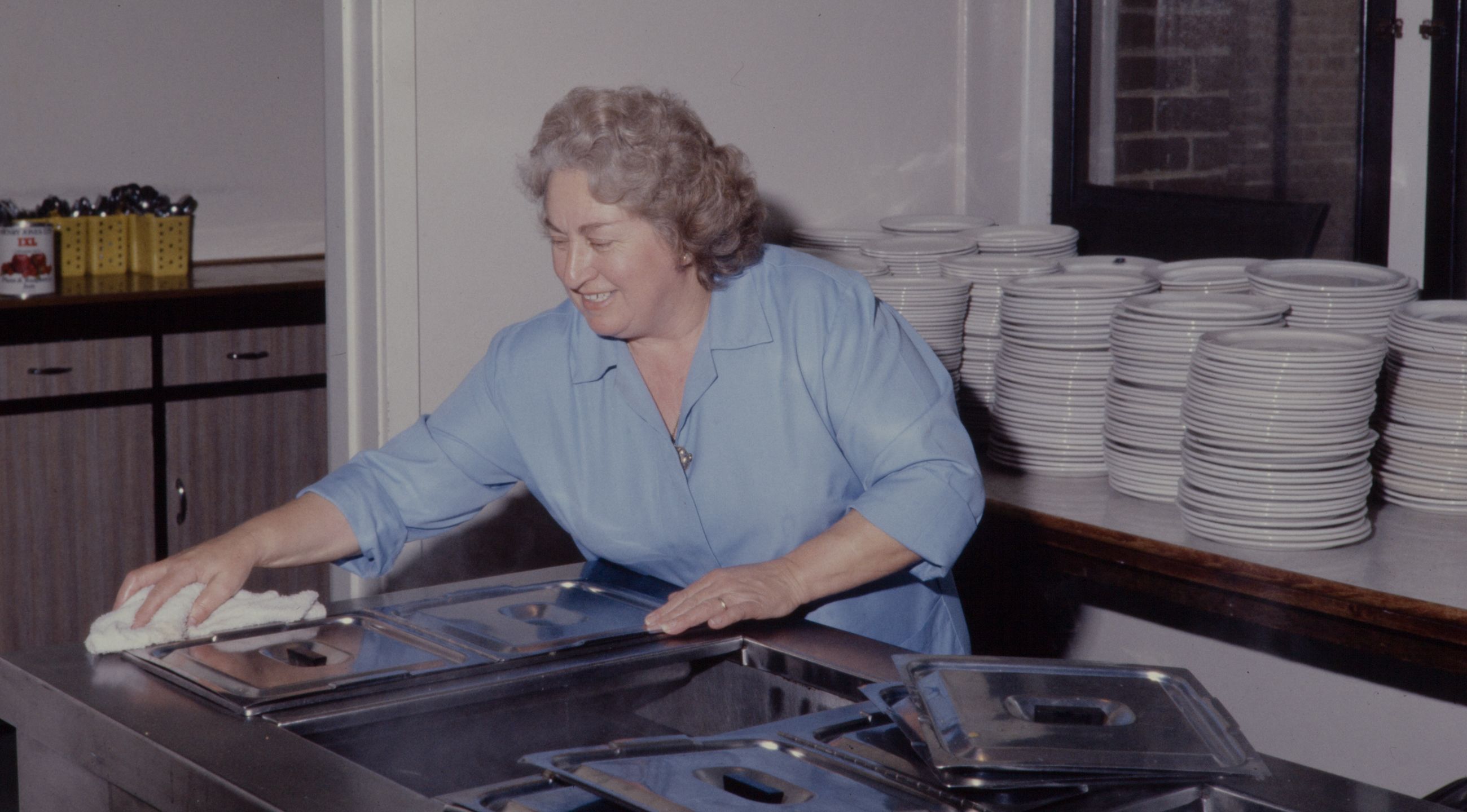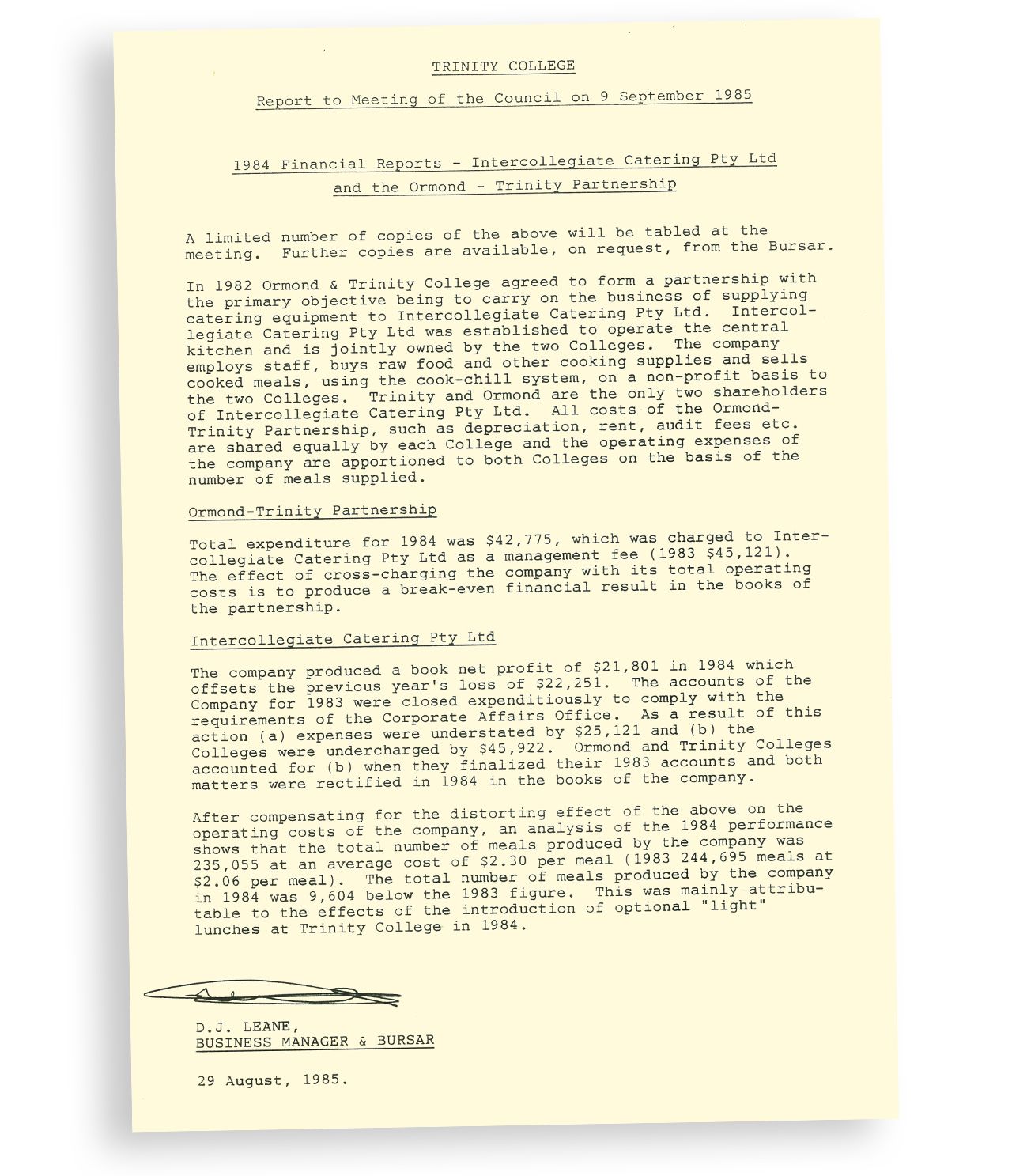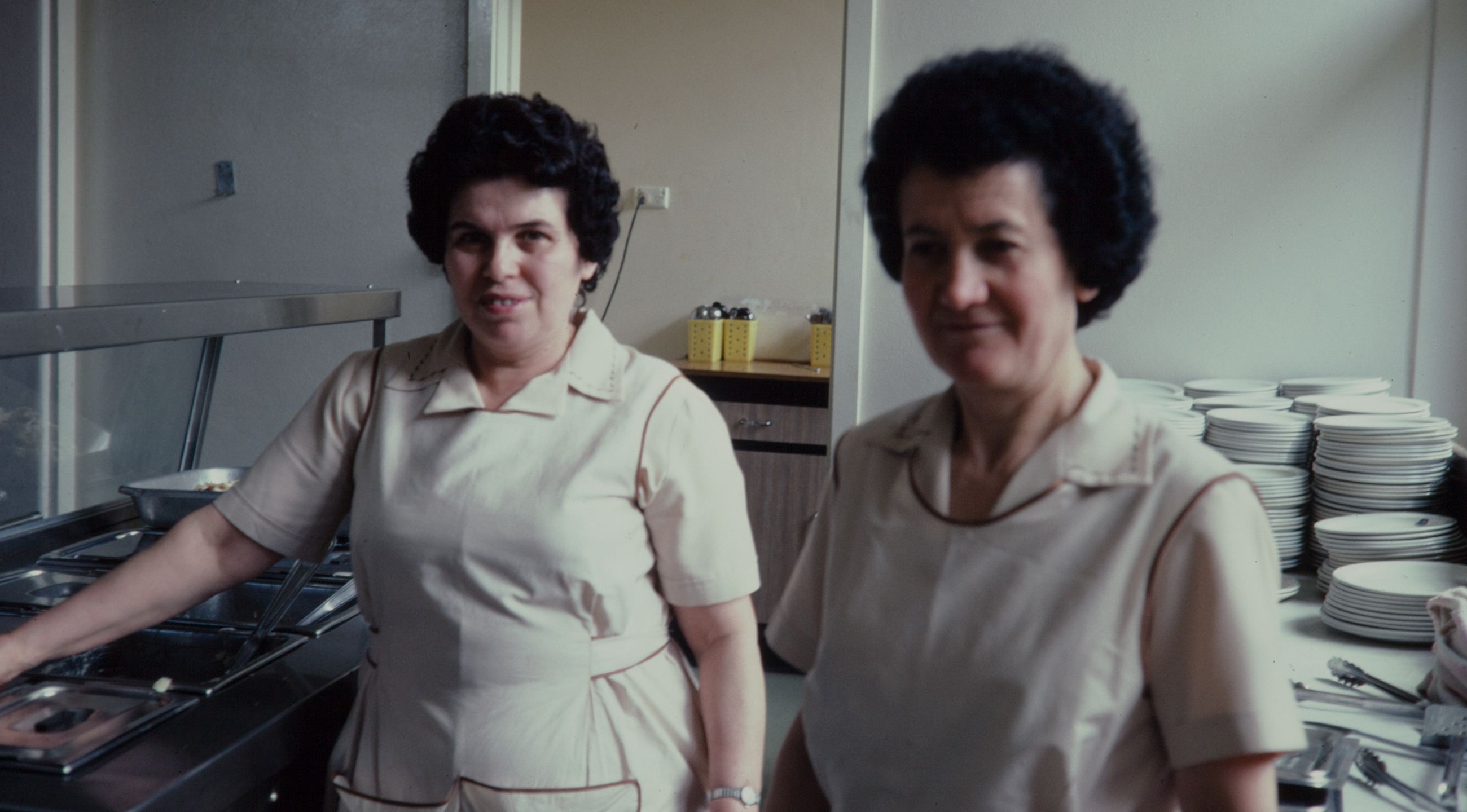Cook-chill
A venture in intercollegiate catering

'The name 'cook-chill' is rather off-putting. On student lips it is more likely to be spoonerised into 'kill-chook' than 'cool chick.'
Commencing as Warden just as Trinity moved to co-residency, Evan Burge inherited a college struggling under enormous financial difficulties. Reduced government funding and changing societal attitudes towards residential colleges in the late 1960s had reduced revenue to enable Trinity to modernise, such that it was said the College had 'the only Melbourne College kitchens fit to be classified as a historical monument'.
In 1983, as Trinity moved towards adopting a new catering structure, the Warden explained the origins and intentions of the new model:
At the University of St Andrew's, Scotland, in November 1980 I first saw how it was possible for a number of colleges to share a single kitchen. On investigating the best system for Australia on my return, I learned that a 'cook-chill' system was preferable in our circumstances to the 'cook-freeze' system that had impressed me overseas.
The name 'cook-chill' is rather off-putting. On student lips it is more likely to be spoonerised into 'kill-chook' than 'cool chick'. Initially it suggests frozen, pre-packed food, with little to commend it either gastronomically or nutritionally. And yet two pairs of colleges - one pair in Perth and the other in Melbourne - have instituted cook-chill catering systems and are very happy with the results. The system deserves a better name.
The College Council were originally impressed by the economics. A normal College kitchen is under-used for most of the day but frantically busy at meal-times. A good proportion of the wages bill goes on overtime payments and penalty rates. This is not so once cook-chill catering is introduced. All the cooking for the week is done between 8 am and 4 pm on weekdays and the savings in labour costs are considerable. The savings are even greater. By working steadily for eight hours a day without periods of either slack or frantic activity, one kitchen can produce enough cooked meals for two colleges, or even three.


Report on the cook-chill system between Trinity and Ormond colleges, 1985
Report on the cook-chill system between Trinity and Ormond colleges, 1985
In Perth, all the food needed by two colleges, St George's and Kingswood, is prepared in the kitchen of an Anglican old people's home. In Melbourne, both Trinity and Ormond are supplied from a kitchen in Ormond, and it should soon be possible to invite another college to join the system. In a few years, this kind of co-operative arrangement must become widespread if colleges are to operate economically.
There are further cost-saving inducements. One is the advantage of bulk buying when several colleges combine. A more important one is the virtual elimination of waste. Preliminary figures from the Ormond-Trinity venture suggest that raw food costs for the two colleges are down by 24% compared with budget.
It has been queried whether substantial savings could have equally been achieved by tightening controls in a conventional kitchen. At the very least, cook-chill provides a method and an incentive to run efficiently.
But surely economics aren't everything?
True, but they are important not only to administrators but equally to students. One goal is to cut the spiralling increases in student fees every year.
The great savings afforded by the cook-chill system involve a fairly heavy capital outlay. In Trinity, because of the 'family service' style of serving formal meals (which demands a large number of expensive stainless steel trays) and because Trinity also purchased a half-share in Ormond's existing kitchen equipment, the initial capital was a massive $95,000. This has been financed by a bank loan. The College expects to recoup this, including interest, within three years. In colleges where cafeteria-style service is the norm, the capital outlay is much lower and the costs can be recouped in two years or even less. For most colleges an initial expenditure of about $25,000 should be enough.
How does the system work? And what is the food like?
Cooking is done in the normal way, though a few dishes (such as poached eggs) are left slightly underdone. It is essential that nothing be overcooked. As soon as the food is cooked, it is placed in stainless steel trays, wheeled to a blast-chiller, and rapidly cooled to a temperature of 3°C. It is not frozen. It is stored in a refrigerated room, and taken to the receiving colleges in an insulated van. Properly refrigerated, it will keep for up to five days, but such a long span is unusual. When it is required, it is heated in a special infra-red oven and served promptly. Food is heated only as it is required - hence, an increase in freshness and avoidance of waste. What is not needed, provided it has not been heated, can be kept for the next day.
The right comparison to make in all this is not between cook-chill meals and home cooking on a small scale, but between cook-chill meals and normal catering practice for large numbers who require their meals to be served in a short time. It is almost unavoidable in the larger colleges, using traditional methods, having quantities of food sitting about at warm temperatures for lengthy periods. There are risks of bacterial contamination and of deterioration in quality and nutritional value. Both risks are greatly reduced by the cook-chill method, provided that temperature control is rigorously maintained. What we have noticed in Trinity, since the system was introduced last February, is that vegetables in particular are fresher and more tasty than under the old methods.
Roast potatoes, however, have been less successful so far in Melbourne than in Perth.
Other ways of cooking potatoes - mashed, boiled in their jackets, a la Lyonnaise - are all excellent. It is possible to achieve excellent results with eggs - fried, poached, or omelettes.
Poultry and fish dishes of a high standard can also be served. Steak can be served attractively, but it is not (in my view) quite as good as steak freshly cooked on the grill.
For special dinners, both Ormond and Trinity have had happy results with Beef Wellington. The basic cooking is done in the central kitchen early in the afternoon, and the fillet steak is wrapped in pâté and pastry dough. It is then chilled. It is finished off in a normal oven at the receiving college and served promptly.
The general view among Trinity students is that the food has improved since cook-chill methods were introduced. Despite its unpromising name, cook-chill has won acceptance, and even acclaim, by our students who were originally sceptical.
A few general points may be of interest. An attitude of openness and trust is vital between the co-operating colleges.
Ormond and Trinity, like Kingswood and St George's, have achieved this to a high degree. Before one starts, it is essential to determine methods of pricing the meals, apportioning the overheads, and owning the equipment. Both in Perth and in Melbourne, the cooperating colleges found it advantageous to form non-profit companies to run the central kitchens. The staff of the central kitchen are employed by the joint companies, which also purchase the raw food. Cooked meals are then supplied at cost to the participating colleges.
The participating colleges do not need to have identical menus or styles of dining. A good deal of individuality is possible. There are savings when some parts of the menu are shared when there is no particular reason to order something different. High-grade cooks are vital, as well as a thoroughly professional catering manager to control recipes, food stocks and work schedules. You cannot get better food out of the system than you put into it.
The high standards of hygiene and planned production which are essential in the central kitchen impose obligations upon the participating colleges. The numbers of those to be catered for need to be submitted well in advance: last-minute changes are expensive and hard to cope with once the food has been ordered. Another obligation, which we at first found surprisingly difficult, is washing up and returning promptly the used steel trays. This requires staff who will do the work, plentiful hot water, and quite a lot of space.
The upshot of all this is that Trinity and Ormond, like their Western Australian counterparts who pioneered the system among Australian colleges, are enjoying better food at less cost, with increasing benefits as the years pass.
Although we could always sell the new equipment and revert to former methods, it is now most unlikely that we shall ever do so.
May there not be other areas - computerised accounting and record keeping for instance - where intercollegiate co-operation has benefits for all?
This article was first published in the Trinity College Newsletter, July 1983


Dr Ben Thomas, Rusden Curator, Cultural Collections
Dr Ben Thomas, Rusden Curator, Cultural Collections





